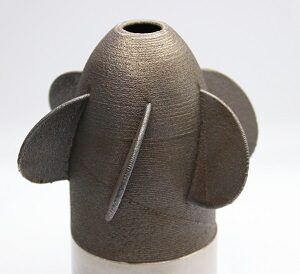Metal Additive Manufacturing is defined as the generation of a shape in metal alloys by depositing successive layers. This technology combines the design flexibility of 3D printing with the mechanical properties of metal. From tooling parts with cooling channels to lightweight structures for aerospace, all applications involving complex metal parts can benefit from 3D printing.

In this process, an electric arc between a substrate, a neutral gas and an electrode generates a plasma that melts a transversely fed metal wire. A protective gas is used to concentrate the plasma and avoid oxidation.
It is possible to use 2 wires at the same time, to work with different alloys or to increase the productivity of the machine.
The system is integrated into a CNC machine with up to 8 axes, for a sealed manufacturing volume of up to 2m x 0.6m x 0.6m.

In this process, 6 diode lasers with a total power of 1.2kW are focused on a metal wire fed through the head. The resulting parts are thinner than with the WAAM. The final surface of the part is the best that can be obtained with a DED process, greatly limiting re-machining.
This head is compatible with most numerical controls in order to be integrated on CNC or robot according to the targeted applications and the sizes of the parts to produce.
A turnkey 3D printer version in 3-axis and wire version only, the MELTIO 450, facilitates the production of spare parts and is easily movable on the scene of operations.

METROM offers a hybrid multi-process, additive and subtractive solution. The machining or printing head is mounted on a pentapod gantry with 5 ball screws. These allow the head to move in a space measuring up to 1m in diameter and 600mm high.
This mobile and flexible system, which can be integrated into a container, allows the generation or repair of massive parts on site with a very high degree of precision.
Titomic is a new metal additive manufacturing tool. It uses a Cold Spray process named “Titomic’s Kinetic Fusion Additive Manufacturing” abbreviated as “TKF AM”, allowing to produce high performance parts and to realize coatings or repairs on demand.
The principle of operation is to accelerate a beam of powder mixed with a gas or compressed air to project it at very high speed onto a substrate.
These powders are then fused thanks to their kinetic energy.
This process allows the shaping of a multitude of alloys in powder form: aluminum, titanium, nickel, copper etc…
Titomic offers two ranges of products:
Titomic’s technology is already being used by leading names in the aerospace, automotive, defense, mining, rail and other industries.
Hamuel is a German manufacturer of machines for machining aerofoils, turbine blades, blisks for energy or aeronautical applications. They have also developed a hybrid solution for machining and laser fused powder projection.
The laser powder bed fusion technology, also called SLM (Selective Laser Melting), is based on the passage of one or more lasers of 200 to 500W on a powder bed in order to assemble the particles between them. This technology allows the production of dense metal parts, which can be machined later, at reasonable costs.
 PRIMA ADDITIVE
PRIMA ADDITIVEPrima uses PBF technology to manufacture small parts. Their machines are suitable for research centers, universities and industries making rapid prototypes. Some of their machines can be equipped with 1 or 2 lasers and a green laser source for the use of copper.
 BLT
BLTBLT manufactures machines specially designed for large parts up to 1200 x 600 x 1500 mm . To have a high productivity, these machines can include up to 12 lasers. In addition to these machines, Multistation offers a service of production of large parts after study of the feasibility according to the rules of Design for Additive Manufacturing of large parts.

Xerion is a German company founded in 1997. In 2018 they launched into additive manufacturing, with the Fusion factory range.
This system makes it possible to produce metal parts very quickly and easily thanks to the BMD (Bound Metal Deposition) process, which consists of FDM-type printing of a metal wire loaded with a binder. This binder is then removed in a debinding oven, and the part is then put into the oven to be sintered. This process has many advantages in terms of simplicity of implementation and safety conditions, since there is no metal powder in suspension or powerful lasers. The system is ultra-compact: the Fusion Factory XS, a complete production line that fits into three highly protective, heavy-duty 19″ housings that can be easily transported on trucks or ships or put into containers.
Our team of engineers is at your disposal for any additional technical or commercial information, such as POC, benchmarks or pre-series.
multistation@multistation.com
+33 2 99 15 35 35
Read more :